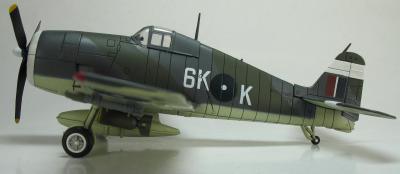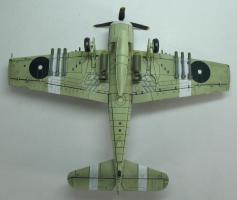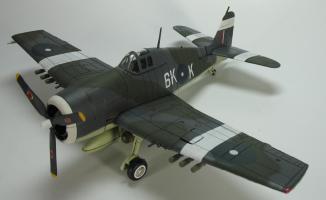Hobby Master Archive
Air Power Propellers 1/72
F6F
F6F Hellcat Fleet Air Arm No.804 Squadron model plane
Hobby Master 1/72 Air Power Series HA1102 Grumman Hellcat Mk. II Fleet Air Arm, No. 804 Squadron, 1945
History of the 804 squadron. After spending time in North Africa and the Mediterranean the 804 squadron was stationed in Northern Ireland and in the summer of 1943 received a new CO Lt. Cdr. Orr ( who was an ace ) as well as the all new Grumman Hellcat I’s to replace their Sea Hurricanes. The British referred to the new planes as “Gannets” until March 1944 and then they too called them Hellcats.
Oct. 1943 saw 804 being assigned to the #7 Naval Fighter Wing where they practiced flying the Hellcats on shore as well as at sea. All this was so they could gain experience with their new planes and would be read to take part in “Operation Tungsten”, the early 1944 air strike on the German ship Tirpitz that had been nestled in a Norwegian fjord. The British were so worried that Tirpitz would head for open water and devastate shipping that was so vital to the island nation, Tirpitz had to be destroyed. 804 was assigned to escort the second wave of bombers, 19 Barracudas that would depart one hour behind the first group. The attack did little more than kill a couple of hundred sailors and caused minor damage that took about two months to repair. On November 12, 1944 the third attack to destroy Tirpitz the British finally succeeded. Lancaster bombers carrying “Tall Boy” bombs managed to get two direct hits that pierced the hull on the port side creating a 200 foot hole and causing internal fires. The magazine exploded and blew “C” turret off and the ship capsized within minutes killing 1,700 German sailors.
The 804 took part in Normandy action and after D-Day 804 was absorbed into the 800 and then 804 was disbanded only to be reformed in September 1944 at Wingfield, South Africa with 24 new Hellcat IIs. In January 1945 the squadron embarked on HMS Ameer to provide cover during the landings on Ramree Island. In April of the same year they were assigned to HMS Empress and took part in attacks on the Andaman Islands and along the coast of Burma. June 1945 the 804 was on the move again but it was back to HMS Ameer in time to participate in strikes on Sumatran airfields and Phuket Island. Their next move was after VJ-Day in November 1945 when the squadron returned home to Great Britain.
Hobby Master HA1102 Hellcat The realism of this Hellcat is so amazing that you will be able to imagine yourself as the pilot who is glued to the tail of a bobbing and weaving Zero as he tries in vain to escape. Hobby Master has included many extras such as an array of weapons and add-ons and other great features to bring you the best possible model. Painted in a camo scheme this FAA ( Fleet Air Arm ) 804 squadron model has the fin flash and roundels of the SEAC ( South East Asia Command ). The British who had refused such aircraft as the P-38 in any numbers chose the Hellcat, so this is quite a statement of confidence in the Hellcat. One of the best ever aircraft of WW II can be yours with this stunning reproduction Hobby Master has made possible.
Hellcat history 1942 saw the design of the prototype of the Hellcat and to make the take-off and landing were even larger than the P-47 in an effort to reduce wing loading and in the process they became the largest wing area of any single fighter of WW II, 334 square feet.
The Grumman Hellcat started out as a variation and replacement for the F4F Wildcat but soon became a much larger and more powerful plane. Designed as a carrier borne fighter to be counter the Japanese Zero the U.S. got a lucky break when a Zero was found completely intact. The plane was transported to the Grumman factory in California where it was flown and test results analyzed. It found the Hellcat to be slightly slower than the Zero so a bigger engine was installed which now gave the plane a top speed of 375 mph, 29 mph faster than the Zero.
The Hellcat was so impressive that it soon became the main shipboard fighter of the US Navy for the last two years of the Pacific War. With well over 5,000 victories in the air the Hellcat was the most successful Allied fighter of WW II credited with 76% of all USN carrier fighter wins. The plane became known as “the Ace Maker”.
Grumman had developed an improved Hellcat, the F6F-5, which utilized a redesigned engine cowl, new ailerons, a strengthened tail, and a water-injection system for the engine, which added 10% to the takeoff performance and increased its armament- carrying capabilities. The F6F-5 was first flown on 4 April 1944, and production continued through November 1945. 930 “Dash-5” Hellcats were delivered to the UK Royal Navy under the Lend-Lease program under the designation Hellcat Mk II and outfitting 14 FAA front-line squadrons.
By November 1945 7,870 F6F-5s were built.
Specifications (F6F-5): Engine: 2000hp Pratt & Whitney R-2800-10W Double Wasp 18-cylinder radial piston engine Weight: Empty 9150 lbs., Max Takeoff 15,410 lbs. Dimensions: Wing Span: 42ft. 10in. Length: 33ft. 7in. Height: 13ft. 6in. Performance: Maximum Speed at 23,500 ft: 380mph Cruising Speed at 6,000 ft: 168mph Ceiling: 37,300 ft Range: 1,530 miles with 150-gallon drop tank Armament: Six 12.7mm (0.5 inch) wing-mounted machine guns Two 1,000-lb bombs, or six 127mm (5-inch) rockets
ammo bay panel in left wing (picture above and to the left) will not be on the production version, it will be a solid wing.
PRE-PRODUCTION PICTURES NOT THE RETAIL VERSION
| Added to archive | 2015-11-19 |
| Last modified | 2015-11-19 |





